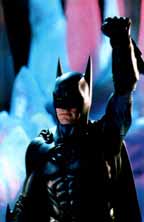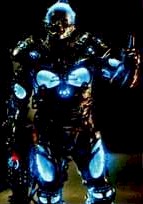|
|
The Deadly Duo
is Back: |
|
|
with co-supervising sound
editors |
||
As
they say in this ego-dominated business, you're only as big as your last movie
success. If that homily really is a barometer of talent, then the supervising
sound editorial team of John Leveque and Bruce Stambler stands head and
shoulders above the rest in Hollywood. That Stambler finally received the nod in
the 1996 Oscar Awards for Best Sound Effects Editing on "The Ghost in the
Darkness" was considered by many in this town to be long overdue; the team
has indeed worked on some of the most innovative movies to grace the silver
screen in recent years, including "Under Siege" (nominated for Academy
and Golden Reels Awards in 1992), "The Fugitive" (Academy/Golden Reel
nominations and a British Academy Award in 1993), "Clear & Present
Danger" (Academy and Golden Reel nominations in 1994), "Batman Forever" (Academy/Golden Reel nominations in 1995), and now this summer's
blockbuster "Batman & Robin."
The
new offering from Warner Bros. marks a reunion with producer Peter
Macgregor-Scott and director Joel Schumacher, the team that brought us 1995's
"Batman Forever." "But this time around," stresses
Macgregor-Scott, himself a former sound editor, "we have an entirely
different look and feel to the characters and story line. But sound remains a
major element in this movie; each character and gadget needs its own distinctive
sound 'signature.' Having worked with John [Leveque] and Bruce [Stambler] and
their team of talented editors from SoundStorm [a leading Burbank-based sound
editorial company] on a number of highly successful films- including 'Batman
Forever'- it was more that natural that we do it again with our latest
adventure."
George
Clooney, star of NBC-TV's highly successful "E.R." series, takes over
as the Bruce Wayne/Dark Knight character, and is joined by Arnold Schwarzenegger
as Victor Fries/"Mr. Freeze," Uma Thurman as the deadly Pamela
Isley/"Poison Ivy," Alicia Silverstone as Barbara
Wilson/"Batgirl." Chris O' Donnell reprises his role as Dick
Grayson/"Robin." Other characters making appearances include Vivica
Fox as Mr. Freeze's moll, and super model Elle Macpherson as Batman's latest
love interest; Pat Hingle and Michael Gough reprise their roles as Commissioner
Gordon and Batman's butler Alfred, respectively.
The
film's plot of revenge and misplaced vengeance is relatively simple. Scientist
Victor Fries is trying to save the life of his wife, Nora, who is dying from a
mysterious disease. The project is unauthorized, and officials come in to clean
out Fries. During a struggle, the cryogenic machine keeping Nora alive is
smashed, splashing Victor with fluid. He now has to create a suit to keep him at
50 degrees below. Eventually, his quest is revenge on Batman; thus, the fun
begin.
Developing
Sound for a "Living Comic Book"
"Sound is now an integral part of any film," confides director
Joel Schumacher. "For a movie like 'Batman & Robin'- which I can best
describe as a 'living comic book'- there are extensive sets and costumes that
need to be detailed with sound. It's very much like a pop opera, with sound
being used along with the dramatic action, music [from leading composer Elliot
Goldenthal], lighting and set design to heighten the fantasy. Sound effects have
become as essential to the story-telling process as the visuals; they help to
amplify and heighten the reality we create on the screen."
"It's
obvious that movie audiences today expect a film like 'Batman & Robin' to
sound as good as it looks," considers John Leveque, who with long-time
colleague Bruce Stambler handled the complex task of selecting and editing the
thousands of sound elements used in the film; in their role as co-supervising
sound editors the duo also oversaw dialog, ADR and Foley editing at SoundStorm- in Hollywood, a movie's supervising sound editor is responsible for
developing all of the new sounds required for a movie. "Filmgoers expect to
be enveloped in clear, vibrant sound that leaves them excited and totally
involved in the film's action; to suspend reality for their visit to the movie
house."
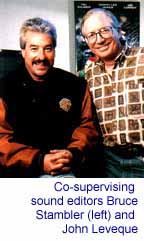 Leveque
recalls the first time he understood the impact that sound design can have on an
audience's total involvement with a film, when he was barely 10 years old.
"I was spending a Saturday afternoon in a dark movie theater. On the
screen, a young boy wanted a gunslinger to show him his six-shooter. The man
stood there, legs apart, right hand just above the pearl grip. Then a blur from
the holster. 'Kablam!' The biggest, loudest, most amazing sound I ever heard. It
was then that my love for movie sound began.
Leveque
recalls the first time he understood the impact that sound design can have on an
audience's total involvement with a film, when he was barely 10 years old.
"I was spending a Saturday afternoon in a dark movie theater. On the
screen, a young boy wanted a gunslinger to show him his six-shooter. The man
stood there, legs apart, right hand just above the pearl grip. Then a blur from
the holster. 'Kablam!' The biggest, loudest, most amazing sound I ever heard. It
was then that my love for movie sound began.
"I've been involved in all aspects of movie making, but I found at an early stage of my career that sound was where I belonged. When I'm working on a good movie with good people, that's the best it can be. And all of this from the dream of a 10-year old boy- the sound of a gun shot, and a movie called 'Shane'."
And this experienced sound editor has a clear blueprint of how he will develop the various elements required to complete a film's soundtrack. "Big, bold, loud.. emotional- that's how I like my sound. The helicopter 'screams' as it careens off the deck of the U.S.S. Missouri in 'Under Siege'. The bus wrapped around the front of the train 'screeches' along the track in 'The Fugitive.' The Smart Bomb finds its target, a tone signals the 'lock,' then a silent 'whoosh' as the bomb falls in 'Clear And Present Danger.' Batmobile zooms. Batcape flaps. Batboat growls. Batarang clangs. All of these- and hundred of others- are a sound-editor's dream"
"A well-crafted soundtrack will help the audience to focus on a particular scene in a movie," Stambler adds, "by complimenting what's happening on the screen. What [director] Joel Schumacher puts on the screen is the blueprint; we design the sound around the action, so that it reinforces the focus of a scene, yet without being distracting. There's a very fine line between too much and too little; we carefully select the right combination of sound effects to draw the audience into the film."
Stambler has been a member of the SoundStorm team since 1989. Known as one of the coolest supervising sound editors in Hollywood, he understands the value of playing as hard as he works. When not thinking of ways to make his Cobra go faster, Stambler can probably be found somewhere in the desert riding fast motorcycles.
The process of designing sound for "Batman & Robin" began, Stambler explains, with the their first meeting with picture editor Dennis Virkler. "Since most of the action material had been shot without sound- after all, 'Batman & Robin' isn't a 'dialog-heavy' film- there was very little audio for Dennis to use when he did his first cut of the film. Having worked with him before on 'Batman Forever,' Dennis wanted us involved so early because he is under such pressure to show a first cut to the director, producer and the film company; he can be more productive is he has a rough sound track to work with.
"So Dennis asked us to build him a guide track so that he could have something to cut against; something that would help give some sense of rhythm. We received a list of specific sounds that Dennis wanted to hear- for example, some bike sound for the chase sequence at the beginning of the film. So we went back to SoundStorm, pulled effects [from the facility's extensive sound-effects library, recorded on a variety of media] and then cut a work track for him. We kept it very simple- less that 60-odd tracks [mixed into a guide track]. During the fight there are 'swishes,' hits, body falls, and so on. And there's the special stuff. For 'Mr. Freeze' we came up with a lot of metal sounds for impacts [during the fight sequences]. Dennis was really into the process! It also gave us a direction; to focus in certain areas of the movie."
As the duo explain, this process was also useful in speeding the process of Temp Dubs, which culminated in a six-track Temp #3 being produced for test screening of the film during early May. "Because there was so much sound design needed on 'Batman & Robin," John Leveque continues, "it really helped us being brought on early in the process. Normally, we receive a rough cut as the starting point for our sound design. Here, because we had this unique opportunity of working with Dennis so early in the movie's development, we could get a good sense of what would be needed for such a sound-heavy movie."
To handle the wide spectrum of sounds required on a busy film like "Batman & Robin," the co-supervising sound editors divided up the assignments; while Stambler looked after 95% of the sound effects and handled overall liaison with the editorial crew, Leveque was responsible for Foley, ADR and dialog, plus the remainder of the effects. "But it's definitely a collective effort," they insist.
Using
Realistic, Natural Sounds
In all of their productions, Leveque and Stambler favor the use of natural
sounds that they record specifically for the movie they're working on. "The
use of realistic, organic-like sounds makes the soundtrack more emotional,"
Leveque considers, "which helps to hold the audience's attention by drawing
them into the film. For high-action movies like 'Batman & Robin,' we prefer
to start with real-world sounds and then weave them together to heighten their
emotional impact."
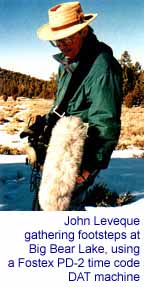 "But
at the same time," Stambler adds, "we need to make sure that we create
breathing spaces between the loud, dramatic scenes, so that the audience can
catch its breath, and not be overwhelmed by the soundtrack. Sometimes it's a
case of 'Less is More.' While we utilized all of our skills to develop loud,
extremely complex sounds for 'Batman & Robin,' we also used the same
sensitivity to back off the sound levels during certain scenes."
"But
at the same time," Stambler adds, "we need to make sure that we create
breathing spaces between the loud, dramatic scenes, so that the audience can
catch its breath, and not be overwhelmed by the soundtrack. Sometimes it's a
case of 'Less is More.' While we utilized all of our skills to develop loud,
extremely complex sounds for 'Batman & Robin,' we also used the same
sensitivity to back off the sound levels during certain scenes."
For many of the key scenes in "Batman & Robin," Leveque and Stambler spent hours developing innovative sounds that would draw the audience into the film's high-intensity action. "We wanted The Batmobile," explains Leveque, "to sound exciting and bigger than life." To help create the unique, multi-layered sound of the Batmobile, Leveque and Stambler visited the Rocket Dyne Space Shuttle facility in Canoga Park, California, where they recorded the intense blast of an Atlas rocket engine.
"The core of the Batmobile sound is an 800-horsepower, street-legal Buick Grand National with a wonderful turbocharger whine," recalls Stambler, whose rare off-hours are often spent around high-power automobiles. "All in all, we used 60 different, individual sounds to build the complex, multi-layered sound for the Batmobile." A race track near to Los Angeles was also rented for a couple of days to record various sounds of a powerful Ducati motorcycle and a rare Porsche 917 12-cylinder racer. Both elements were to find their way into the new Batbike sound creation, which we see Robin riding early in the film.
To create the Bat Cave featured in "Batman & Robin," Leveque and Stambler traveled to Puerto Rico to record the sounds of a real bat cave. "We were able to make some remarkable recordings that we used throughout the movie," Leveque says. "The overheated environment of the bat cave, with 100% humidity in complete blackness got us the sounds of bats, but also the chance to trudge through ankle-deep bat guano, wall-to-wall cockroaches, tarantulas and snakes!"
For the skating sequence that extends for much of the first two reels of the film- and which introduce that character of "Mr. Freeze"- Leveque and Stambler hired an ice rink in nearby Pasadena, and recorded a trained skater and well as members of a hockey team. "While we were after the precision of the female ice skater, and her ability to make timed 'swoops' and turns that we needed in specific scenes," Leveque recalls, "we also need a lot of 'clumsy,' group sounds that we could use for the team of goons that move around in the background. We ended up recording a lot a mono and stereo material on a Fostex PD-2 timecode DAT machine."
And to complete their sound palate of colors for "Mr. Freeze," the team moved into a Foley Stage at Warner-Hollywood with a series of frozen and semi-frozen material, including ice blocks, as well as a cylinder of liquid nitrogen. "We recorded a series of venting and exhaust sounds with the nitrogen," Stambler recalls, "which we used as a basis for the 'freeze gun' that Arnold [Schwarzenegger] uses to immobilize his enemies." The sounds were also used as composites for a rather larger 'ray-gun' that "Mr. Freeze" uses on Gotham City. For footfall and general sounds of snow and ice being chipped and squashed, the team also traveled to nearby Big Bear Lake, high in the mountains east of Los Angeles, to make a series on outdoor ambiances and close-up recordings.
One of their favorite sounds used in the film came about by accident, as Bruce Stambler recalls. "We needed a large, 'swooshing' sound for Batman's cape. We had already made a number of recordings of bat wings that were very good. But we lacked a 'big' sound that would really give the idea of Batman rising into the air and moving off at high speed."
As fate would have it, at Warner Bros. Studios in Burbank, north of Los Angeles, the facility's world-famous water tower had been covered in a massive tarpaulin. "During a windy rainstorm," Stambler recalls fondly with a smile, "the tarp came loose and ended up streaming off into the air held only a single tether. We snuck under the tower with our microphone and a portable DAT recorder. What you hear in the movie is the sound of this enormous tarp flapping, whipping and snapping around in the gale-force wind. It had exactly the right power, 'crack' and 'woosh' that we needed!"
"Just as an artist needs a palette of colors to render a masterpiece," Leveque reflects, "so we use a vivid spectrum of individual and combined sounds to create a finished soundtrack. Working on 'Batman & Robin' let us extend our art in exciting new directions. Contributing to this sensational film was a rewarding experience.''
The majority of effects tracks were edited on SoundStorm's series of Foundation digital workstations, which were used to prepare six-track reels for the series of Temp Dubs. Fairlight MFX-3 workstations were used for Foley editing, primarily because that was the format delivered to the team from Warner-Hollywood's Foley stage. "The majority of sounds are normally laid down in mono," Stambler says, "apart from some selected stereo backgrounds, which can help create a sonic environment. After all, a good effects mixer will be able to take a mono cue and process it into a realist-sounding stereo effect, that is more versatile than if we gave them a two-channel element."
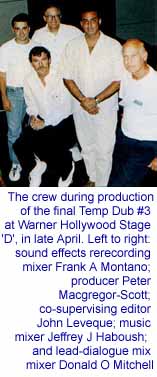 Temp
Dubs and Finals at Warner-Hollywood Studios
Temp
Dubs and Finals at Warner-Hollywood Studios
With the sound elements coming together under the direction of Stambler and
Leveque, plus their crew of close to 40 full- and part-time effects, Foley, ADR
and dialog editors at SoundStorm in late March, the focus of activity moved to
two dubbing stages at Warner-Hollywood's facility. Because of an inevitable time
crunch, Stage "C" and "D" were pressed into to service
during production of a series of three Temp Dubs.
Unlike what has become "standard" Hollywood practice, Stambler and Leveque do not consider Temp Dubs not be a necessary evil as they move towards the final re-recording of the soundtrack. "Rather than use the expression 'Temp Dub'," offers John Leveque," we prefer to refer to them as 'Experimental Mixes'- the first step in the process of producing the final mix, and one that let us develop the soundtrack as the editing process continues, and we begin to develop the look and feel for the soundtrack.
"We select and cut sounds that will appear in the final film, not ones that will be totally replaced later. In this way we can concentrate on the layering and 'detailing' process,' and also provide the directors, producer and picture editor with a more finished audio track on each Temp, than if we were just pulling sounds without much thought of their being used again. Also, we are still waiting for opticals, CG and other visual elements; we were also working with a [temporary] music track for the Temp Dubs." Composer Elliot Goldenthal didn't begin the scoring process until a week after the final Temp Dub. While Stambler supervised Temp Dub mixes in Stage "C" with Donald Mitchell, Leveque handled similar duties in Stage "D" with Frank Montano and Jeffrey Haboush.
Prior to the finals, Don Mitchell handled two weeks of dialog, ADR and crowd-ADR pre-dubs in "C," while Frank Montano took over "D" for his complex effects pre-dubs. Foley pre-dubs, backgrounds and additional materials were also handled by re-recording mixer Kevin Carpenter in Studio #2 at nearby Warner-Burbank. Then, in early-May, the re-recording crew of Mitchell/dialog, Montano/effects and Jeffrey Haboush/music gathered in "D" for the finals and print mastering.
"I prefer to remain in one room for the finals," Mitchell explains, "mainly to ensure a consistent mix. Even though they measure identically, I've found that mixes from the smaller Stage 'C' sound softer than those made in 'D,' because of the closer location of the screen to the console.' Both rooms feature identical Harrison PP-1 Re-Recording Consoles equipped with Uptown moving-fader automation.
"Don Mitchell and his crew are the best in the industry," confides producer Peter Macgregor-Scott. "I've been working with this dubbing crew for the past six years, and am delighted at the delicate touch and attention to detail that Don brings to a mix. We have dialog and ADR elements recorded in different locations all over the world; Don has been able to blend and sweeten them into a seamless creation.
"And [effects mixer] Frankie Montano is a 'Mozart'- aside from being technically proficient, he is artistically competent at producing wonderful, high-energy tracks for me; he's the finest effects mixer I've ever encountered!"
Lead/dialog mixer Don Mitchell recalls that 95% of the dialog on "Batman & Robin" was looped. "We have so much steam, prop and other noises on the production track, that we had to replace most of the lines. Also, in certain scenes Arnold [Schwarzenegger] was difficult to hear clearly, because of his costume.
"During the pre-dubs, we pitch-shifted George Clooney's voice down by about 5% when he appears as Batman, to give it more depth and resonance, and to distinguish the two roles. For [voice processing of] 'Mr. Freeze,' we'll use more of a metallic feel, with a Lexicon [480XL] or a flanger. "
For the finals, Mitchell produced a six-track pre-dub of production dialog- using one track for each of the principal actors- and a six-track of looped lines. Also prepared were two, 6-track pre-dubs of group dialog (particularly for the skating sequences in reels #1 and #2), some laid out as LCR sets, and others as full L, C, R, LS, LR and Boom elements.
"On a high-action movie like this," reflects sound effects mixer Frank Montano, "there is the temptation to make the tracks as dynamic as possible. But the end result can be a soundtrack that is exhausting to listen to. I prefer to leave space in the track for the audience to rest, and then build to the next dramatic action. You need to carefully choose where and when add sound effects." For the majority of reels, Montano prepared a total of some 20, 6-track pre-dubs and sweetener tracks. "While I might not need all of them all of the time in the finals, 'I'd Rather Be Wide that Tied'," he says.
 Because
the picture hadn't been locked and still lacked some opticals as the crew
started pre-dubs- composer Elliot Goldenthal was also completing the film
score- the use of 6-track pre-dubs allowed these elements to be edited
straight across to accommodate inevitable picture and editorial changes prior to
finals and print mastering of the 5.1-channel soundtrack.
Because
the picture hadn't been locked and still lacked some opticals as the crew
started pre-dubs- composer Elliot Goldenthal was also completing the film
score- the use of 6-track pre-dubs allowed these elements to be edited
straight across to accommodate inevitable picture and editorial changes prior to
finals and print mastering of the 5.1-channel soundtrack.
Edited six-track pre-dubs mastered to 35 mm mag were also transferred to a series of SoundStar DMS (Digital Machine-Room System) hard drives, for direct digital playback on the dubbing stage. DMS was also used to replay all elements for the pre-dubs; SoundStorm's edited tracks prepared on digital audio workstations were transferred directly, D-to-D to the system's hard drives. (Contrast this with the use of analog multitracks during the series of Temp Dubs.) The instant-access and enhanced playback fidelity of these new-generation "Digital Dubbers" was described as offering a dramatic improvement over conventional mag dummies. A recorder version of DMS is also under development.
Designed by a team of engineers based at SoundStorm, SoundStar DMS results from many years of hands-on experience in all aspects of audio post production. The compact system, described in a companion sidebar, allows up to 48 digital channels to be housed in the same space as a single 35 mm mag dubber, and up to, 96 channels in a single rack cabinet.
As effects mixer Frank Montano puts in most succinctly, "Good sound is invisible; bad sound gets noticed. But if the movie has the name 'Batman' in the title, don't sit in the first row!"
"Batman & Robin" Editorial
and Post Production Crew
Supervising Sound Editors: John
Leveque and Bruce Stambler.
Re-Recording Engineers: Donald
Mitchell/Dialog/Frank
Montano/Effects/Jeffrey Haboush/Music/Kevin Carpenter/Effects.
Lead Recordist:
Gary Ritchie.
Sound FX Editors: Steve Mann,
Glenn Hoskinson, Kim Secrist, Marshall Winn, Aaron D. Weisblatt, Steve Nelson,
William L. Manger, Jay Nierenberg, Donald L. Warner, Shawn Sykora and Gordon
Ecker.
Sound Design: Lance Brown.
Dialog Supervisor: Becky Sullivan.
Dialog Editors: Gordon Davidson, Robert
Troy and Carin Rogers.
ADR Supervisor: Fred Stafford.
ADR Editors: Bobbi Banks, Denise M.
Horta and Lee Lemont.
Foley Supervisor: Michael Dressel.
Foley Editors: Bob Beher, Pamela
Bentkowski and Scott Curtis.
Assistant Sound Effects: Gary Blufer,
Carl D. Ware, Matthew C. May, Jeffrey Cranford, Paul Aulicino, Steven Gerrior
and Dana Leblanc.
Assistant ADR Editors: Marc Deschaine
and Lori Martino.
FX Coordinators: John Michael Fanaris
and Blake Marion.
Audio Layback: Kelly Cabral and
Jennifer Mann.
ADR voice Casting: Barbara Harris.
Foley Artists: John Roesch and
Hilda Hodges.
Foley Mixer: Mrya Jo Lang.
Foley Recordist: Carolyn Tapp.
Musical Score: Elliot Goldenthal.
SoundStar DMS (Digital
Machine-Room System)
SoundStar was formed in 1994 to develop a
digital record/playback system that would combine all of the advantages of mag
film with the speed and expanded functionality of a non-linear digital
workstation. The DMS (Digital Machine-Room System) provides up to 96 channels in
a single rack cabinet, and is designed to slips tracks like a standard mag
dubber.
A
basic system consists of a Stage Interface (SIU), Master Control (MCU) and
multiple hard-drive dubbers. A DMS system can be configured from a stand-alone
16-track channel system to a virtual machine room of 1,500 or more channels,
using hard disk or optical drives. The SIU handles all timecode I/O and
transport control from the console automation system via conventional 9-pin
serial protocols, TimeLine Lynx II commands, or a Ketcham Box
DMS
is based on the Euphonix-Spectral Prisma Digital Audio Engine, with highly
modified software that handles file management and disk interface. Spectral's
Translator eight-channel digital audio format converter handles Alesis ODI
Optical, Spectral SMDAI, Tascam TDIF-1 and Yamaha Y2 digital I/O signal formats.
Systems are configured for network operation from a single controller for a
stand-alone use, or multiple control points for larger systems requiring access
from the machine room as well as each mix position, utilizing SoundStar's
proprietary TCP/IP, Ethernet based protocol; custom WAN configurations are also
available.
"Working
with the mixers at Warner-Hollywood Studios enabled us to be sure that DMS
emulates all of their present-day procedures," says Randy Heiss, SoundStar
VP of Engineering, "and offers all the familiar features, such as reverse
play, scrub, jog, cue delay and advance." System outputs can be quickly
configured as mono or grouped as stereo, three-, four- or six-track units. Once
configured, the tracks can be advanced/delayed as a unit. Internal patching of
tracks to outputs with the graphical user interface and automated track patching
speeds up reel changes, and is as easy as using a traditional patch bay. Output
channels are routed through conventional patchbays, allowing DMS to be run
transparently with other source machines.
Either
650 MB and 1.2 GB MOs are currently used to transfer material from editorial
rooms into the DMS' hard drives, which are capable of handling real-time
playback of eight channels per drive configuration. Subsequent versions will
offer direct OMFI-compatibility, in addition to direct importing of standard
digital-audio file formats.
Photographs ©Warner Bros./Universal Pictures
and ©Mel Lambert All rights reserved.
![]()
Copyright 1997-2022. All Rights
Reserved.
Last Revised: 10.03.22
